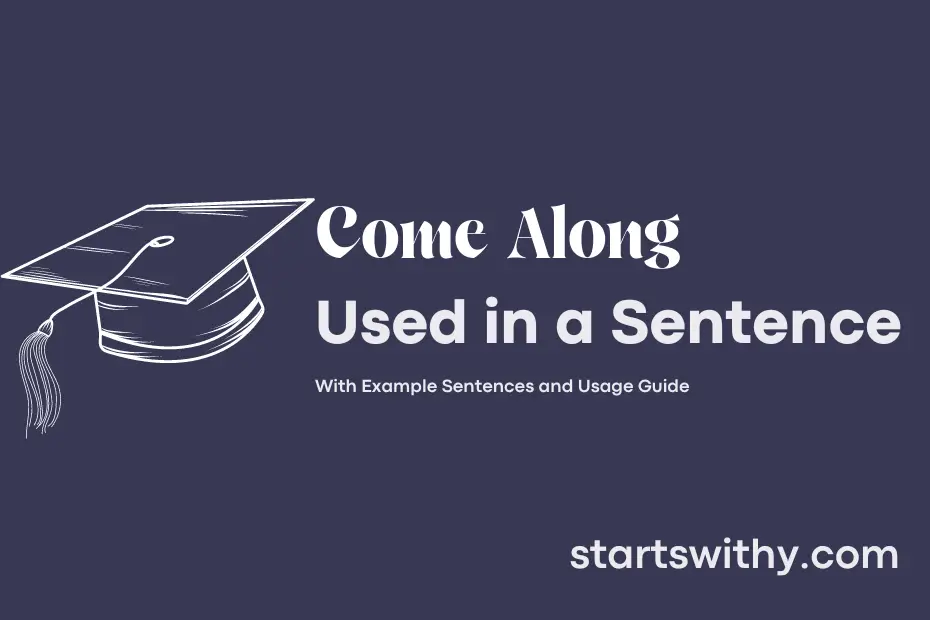Have you ever been in a situation where someone unexpectedly joined you in an activity or conversation? That’s essentially what “come along” means – to accompany someone or join in an event or journey. This phrasal verb signifies tagging along or participating in something already in progress.
In casual conversations or formal settings, “come along” is commonly used to invite someone to join an ongoing action or to update on the progress of something. Learning how to use this expression correctly can help improve your communication skills and make interactions smoother.
7 Examples Of Come Along Used In a Sentence For Kids
Come along with friends to play in the playground.
Let’s come along and dance to the music.
We can come along and eat lunch together.
Everyone, come along and sit in a circle.
Let’s come along and see the beautiful flowers in the garden.
It’s time to come along and learn something new.
Tomorrow, come along to the school for a fun picnic.
14 Sentences with Come Along Examples
- Come along with me to the library to study for our upcoming exams.
- Have you finished your assignment? Let’s come along together to submit it before the deadline.
- Don’t worry about finding a seat in the cafeteria, just come along and join our group.
- Come along to the campus event this evening, it’s going to be a lot of fun.
- Let’s come along to the sports complex and join the yoga class for some relaxation.
- Have you heard about the guest lecture happening tomorrow? You should definitely come along.
- Come along to the bookstore with me, I need to buy some textbooks for the new semester.
- Don’t spend too much time in your room, come along and join the study group for some productive revision.
- Feeling stressed about the upcoming presentations? Come along to the workshop on public speaking for some tips and advice.
- Instead of studying alone, why don’t you come along and join our group study session?
- Planning a trip during the break? Come along with us and explore a new destination together.
- Need help with your project? Come along and meet with the professor during office hours.
- The campus club is organizing a movie night, do you want to come along and watch a film with us?
- Feeling homesick? Come along and join the cultural club’s event to connect with fellow students from your hometown.
How To Use Come Along in Sentences?
Come Along is a versatile phrasal verb that can be used in various contexts. When Come Along is used, please follow these guidelines to ensure you are using it correctly in a sentence.
Step 1: Identify the main subject or group of people that are moving from one place to another. This subject should be the person or persons who will be joining or following someone else.
Step 2: Insert the main word Come Along into the sentence after the subject. This indicates that the subject is moving together with someone else or joining a particular group.
Step 3: Ensure that the sentence flows naturally and clearly conveys the idea of accompanying someone or following a person to a specific location or event.
Example sentence: I invited my friends to Come Along to the movie theater with me.
In this sentence, “I” is the main subject, “my friends” are the individuals being invited, and “Come Along” signifies that they are invited to accompany “I” to the movie theater.
Remember, Come Along can also be used to encourage someone to progress or develop positively in a situation. For instance:
Example sentence: She has shown great talent in art and I hope she continues to Come Along in her artistic journey.
Using Come Along in your sentences adds a touch of inclusivity and represents unity and movement. Practice using it in various contexts to become more comfortable with its application.
Conclusion
In conclusion, the phrase “come along” is commonly used in English to indicate progress, development, or movement with someone or something. Whether referring to a person accompanying others or an event unfolding in a certain way, this versatile expression can be adapted to various contexts. For example, “The project is coming along nicely” implies that the project is progressing well, while “Let’s go, come along” suggests moving together with someone.
Understanding the nuances of phrases like “come along” can help individuals effectively communicate in informal settings and everyday conversations. By incorporating such idiomatic expressions into their language, speakers can convey a sense of cooperation, progression, or participation, adding depth and subtlety to their interactions.




